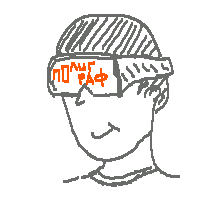Fake Door as part of Customer Development
I have a knife, there is a crossbow,
They serve me for a thousand years.
(c) Kish
Suppose you need to check how much the new feature will be in demand by customers. Often, this is solved by interviewing, surveys, etc. These remarkable approaches have their pros / cons, so consider an alternative option and when it is justified to use it.

We will talk very quickly - just to determine in which subject field we will work. Customer Development or customer development is a set of approaches that solve a known problem: to understand who your customer is and what is in his head - to use this information for the development of your product.
This approach consists of several steps:

Interviewing people can give excellent results, but is fraught with risk (one must be able to ask the right questions) and time consuming. Therefore, consider the alternative, its pros and cons.
You have a Search button on your site that doesn't actually work. You record the number of clicks on this button, thereby measuring the interest in the feature on the part of users. After clicking, bring the user an apology or otherwise smooth out a bad customer experience (see below).
The advantages of this approach:
Minus one, but global - bad customer experience. The user expects from pressing a button one, and gets a completely different. You can still forgive a start-up or a small company, but what to do in the case of a bank or carrier? Can medium and large companies use this approach?

Solution 1. Beta testers
Any company has loyal customers. There are pioneer customers. There are expert clients who love to give advice. Invite them to take part in product testing. Connect gamification to bring a little more fun and motivation. Thus, you will receive a huge benefit for yourself, and additional appreciation from customers - they will know for sure that they are managing the development of the company.
Such a decision is justified if you have quite a few products, you need frequent releases, you actually hear customers and you have Fake Door is just one of many approaches. Ie, most likely, you already have an integrated infrastructure into which you can embed an additional element in the form of a Fake Door.
Solution 2: Buns
If your company operates in the B2C market, then a loyalty program is likely to be present. It is very well suited for such an event, as participants always welcome points and their acquisition will almost certainly outweigh the negative experience. Of course, there is no need to abuse here either, and it is better to limit yourself to two or three cases per year per customer.
If you do not have a loyalty program, but there are attributes (pens, mugs, etc.), then they are also excellent, because apart from an apology, they will also serve as your advertising.
The solution with the buns has its price in the literal sense, but in certain cases, it can be quite justified.
Solution 3. Smile and wave
Here everything is simple - in the case of a click on the fake element, we do it ten times, we apologize and remove the feature out of sight of the user who stepped on it. Great for startups and small companies.
We have already talked about these moments, so let's just summarize.

Landing Page can also be used as a sales tool that emphasizes product strengths for a specific audience, and as a Fake Door, when the call-to-action button leads to nowhere (enter an e-mail and we will notify you on day X). Of course, many of you have done so often.
The nuance is that the landing page sets a certain context within which it is allowed to do fake things. For example, if you are describing a new feature or product. However, if you have a Fake Door in the real environment of the user with whom he is used to interact, then without proper preparation (see Solutions above), this can lead to rather negative consequences.
Those. You can use Fake Door on the landing page “now and immediately”. Include Fake Door in the contour of the real environment, preferably with a certain preparation.
Fake Door is only part of the global Customer Development approach, along with landings, concierge tests, MVP, surveys, etc. It is ideal for testing hypotheses in minimal time and gives very truthful results. However, the method is quite risky and involves a series of preliminary actions.
They serve me for a thousand years.
(c) Kish
Suppose you need to check how much the new feature will be in demand by customers. Often, this is solved by interviewing, surveys, etc. These remarkable approaches have their pros / cons, so consider an alternative option and when it is justified to use it.

Customer Development (CustDev)
We will talk very quickly - just to determine in which subject field we will work. Customer Development or customer development is a set of approaches that solve a known problem: to understand who your customer is and what is in his head - to use this information for the development of your product.
This approach consists of several steps:

- formulation of hypotheses;
- search for people to test hypotheses;
- interviewing or using other approaches to get feedback (← our step );
- analysis of results;
Interviewing people can give excellent results, but is fraught with risk (one must be able to ask the right questions) and time consuming. Therefore, consider the alternative, its pros and cons.
Fake Door in a nutshell
You have a Search button on your site that doesn't actually work. You record the number of clicks on this button, thereby measuring the interest in the feature on the part of users. After clicking, bring the user an apology or otherwise smooth out a bad customer experience (see below).
pros
The advantages of this approach:
- Minimum time (cash) costs. All that needs to be done is to arrange one or several fake elements and hang statistics on them.
- The veracity of the results. Let's make a reservation that often users put tight curiosity somewhere, but usually there is a correlation. Those. if two fake features are placed and one of them has N times more clicks, then this functionality will most likely be in demand in the future. Clarify that the number of clicks should be significant - depending on the context.
- Variety of scenarios. Suppose you have an online shoe store and you want to understand which new directions it is best to launch on the eve of summer. You have two new fake elements: winclipers and jackboots (do not ask what it is :). Inside each have fake models with specific colors, sizes, etc. As a result, you can get the most popular models, including their color and size. Those. Fake Door does not mean placing only one element, but allows you to create any flexible scripts that solve your problems.
- Lack of interference interviewing. Customer Survey is a powerful tool for testing hypotheses and ideas. However, within the framework of it, it is necessary to fight the principle of Dr. House: “Everyone lies”. This is a known issue and an experienced CustDev specialist is excellent with this sign. But finding such experts is not easy. The Fake Door approach smoothes this situation, since it solves a more straightforward task - it does not try to find insights, but tests a specific hypothesis through the visual series.
Minuses
Minus one, but global - bad customer experience. The user expects from pressing a button one, and gets a completely different. You can still forgive a start-up or a small company, but what to do in the case of a bank or carrier? Can medium and large companies use this approach?

Solution 1. Beta testers
Any company has loyal customers. There are pioneer customers. There are expert clients who love to give advice. Invite them to take part in product testing. Connect gamification to bring a little more fun and motivation. Thus, you will receive a huge benefit for yourself, and additional appreciation from customers - they will know for sure that they are managing the development of the company.
Such a decision is justified if you have quite a few products, you need frequent releases, you actually hear customers and you have Fake Door is just one of many approaches. Ie, most likely, you already have an integrated infrastructure into which you can embed an additional element in the form of a Fake Door.
Solution 2: Buns
If your company operates in the B2C market, then a loyalty program is likely to be present. It is very well suited for such an event, as participants always welcome points and their acquisition will almost certainly outweigh the negative experience. Of course, there is no need to abuse here either, and it is better to limit yourself to two or three cases per year per customer.
If you do not have a loyalty program, but there are attributes (pens, mugs, etc.), then they are also excellent, because apart from an apology, they will also serve as your advertising.
The solution with the buns has its price in the literal sense, but in certain cases, it can be quite justified.
Solution 3. Smile and wave
Here everything is simple - in the case of a click on the fake element, we do it ten times, we apologize and remove the feature out of sight of the user who stepped on it. Great for startups and small companies.
Restrictions
We have already talked about these moments, so let's just summarize.

- Lack of insights. Fake door is testing the hypothesis in the forehead - i.e. gives no clues as to why it worked or not and does not give any other additional information.
- Distortion of data. If you go too far with the visuals or the placement of accents (for example, a bright selection of an element on the page), then users can click on a new “square” just for the sake of curiosity. This is an important point, because any new product element is usually somehow highlighted and the main difficulty is to maintain a balance - that is, so that the appearance clearly defines the purpose of the feature and does not require going inside to clarify the details.
Fake Door and Landing Page
Landing Page can also be used as a sales tool that emphasizes product strengths for a specific audience, and as a Fake Door, when the call-to-action button leads to nowhere (enter an e-mail and we will notify you on day X). Of course, many of you have done so often.
The nuance is that the landing page sets a certain context within which it is allowed to do fake things. For example, if you are describing a new feature or product. However, if you have a Fake Door in the real environment of the user with whom he is used to interact, then without proper preparation (see Solutions above), this can lead to rather negative consequences.
Those. You can use Fake Door on the landing page “now and immediately”. Include Fake Door in the contour of the real environment, preferably with a certain preparation.
Conclusion
Fake Door is only part of the global Customer Development approach, along with landings, concierge tests, MVP, surveys, etc. It is ideal for testing hypotheses in minimal time and gives very truthful results. However, the method is quite risky and involves a series of preliminary actions.
